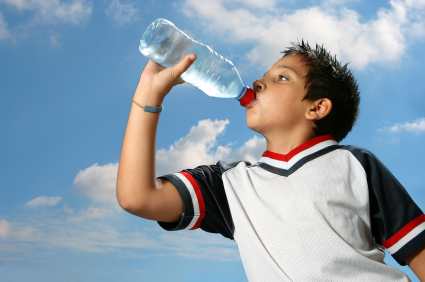Here are the key points to keep in mind in making sure your child drinks enough fluids while playing sports to perform at her best and avoid dehydration:
- Kids should drink before, during and after sports.
To prevent dehydration, or, worse yet, heat illness, you should encourage your child to drink cool fluids before, during, and after physical activity.

- Kids should drink on a schedule, not when thirsty. Your child need to regulate his fluid intake by drinking according to a schedule, rather than in response to thirst, because thirst is not an accurate measure of a child's need for fluid. By the time your child says he is thirsty, he is already dehydrated. Consuming cool fluids at regular intervals during exercise protects your child's health and optimizes athletic performance.*
- Kids should drink from their own water bottles. Children should have their own personalized water bottles and need to be reminded to drink 5 to 9 ounces (10 to 18 1/2 ounce "gulps") every 20 minutes during activity, depending on weight (Teenagers should drink more). Younger children should be given water bottles with marks on the sides showing how much they should drink each time or told how many "gulps" to drink.
- Kids' fluid intake needs to be supervised. Children do not instinctively drink enough fluids to replace water losses, so it is essential that you watch to see how much water they actually drink. Parents should remind their kids to drink to stay hydrated, and make sure that their coaches see that they drink enough fluids during practices and games.
- Kids need to be watched for signs of heat illness. During prolonged exercise, children and adolescents may not recognize the symptoms of heat stress and may push themselves to the point of heat-related illness. It's your job, and the coach's, to recognize the warning signs and act immediately.









